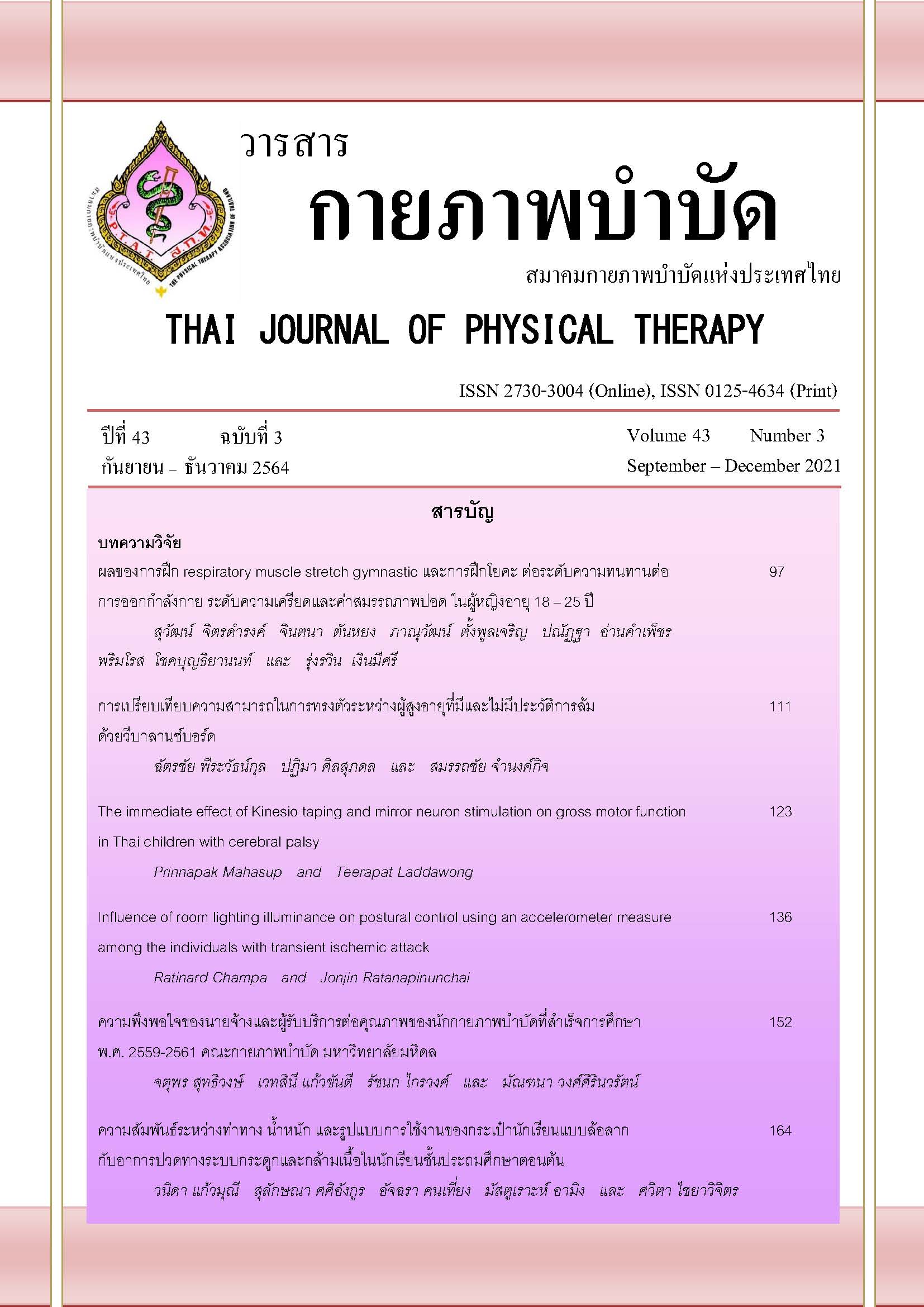ผลทันทีของการติดเทปไคเนซิโอร่วมกับการกระตุ้นเซลล์กระจกเงาต่อความสามารถด้านการเคลื่อนไหวในเด็กภาวะสมองพิการไทย
Main Article Content
บทคัดย่อ
ที่มาและความสำคัญ: ภาวะเด็กสมองพิการเป็นกลุ่มอาการของเด็กที่เกิดจากความผิดปกติของสมองอย่างถาวรเนื่องจากสาเหตุหลายประการ ส่งผลให้เกิดพัฒนาการที่ผิดปกติและล่าช้า การรักษาด้วยการติดเทปไคเนซิโอร่วมกับการรักษาด้วยโปรแกรมกายภาพบำบัดสำหรับพัฒนาทักษะการเคลื่อนไหวโดยกระตุ้นการทำงานของเซลล์กระจกเงาในรูปแบบวีดิทัศน์จัดเป็นการรักษาอีกทางเลือกหนึ่งที่สามารถนำมาประยุกต์ใช้ในเด็กภาวะสมองพิการได้จริง และมีแนวโน้มที่สามารถส่งเสริมให้เกิดการพัฒนาทางด้านการเคลื่อนไหวในเด็กภาวะสมองพิการได้
วัตถุประสงค์: เปรียบเทียบคะแนนความสามารถด้านการเคลื่อนไหวด้วยแบบประเมิน GMFM-66 ระหว่างกลุ่มเด็กที่ได้รับการรักษาด้วยการติดเทปไคเนซิโอเพียงอย่างเดียว กับกลุ่มเด็กที่ได้รับการรักษาด้วยการติดเทปไคเนซิโอร่วมกับการรักษาด้วยโปรแกรมกายภาพบำบัดสำหรับพัฒนาทักษะการเคลื่อนไหวโดยกระตุ้นการทำงานของเซลล์กระจกเงาในรูปแบบวีดิทัศน์
วิธีการวิจัย: อาสาสมัครเป็นเด็กภาวะสมองพิการชนิด spastic diplegia อายุ 5-12 ปี มีระดับความสามารถด้านการเคลื่อนไหว (GMFCS) อยู่ในระดับ 1-3 จำนวน 30 คน แบ่งเป็นกลุ่มทดลองและกลุ่มควบคุม กลุ่มละ 15 คน กลุ่มควบคุมจะได้รับการติดเทปไคเนซิโอด้วยเทคนิคกระตุ้นการทำงานของกล้ามเนื้อ tibialis anterior และ rectus femoris ร่วมกับเทคนิคกระตุ้นการทำงานของข้อเท้า เป็นระยะเวลา 60 นาที ส่วนกลุ่มทดลองจะได้รับการรักษาด้วยโปรแกรมกายภาพบำบัดสำหรับพัฒนาทักษะการเคลื่อนไหวโดยกระตุ้นการทำงานของเซลล์กระจกเงาในรูปแบบวีดิทัศน์ เป็นระยะเวลา 60 นาที ร่วมกับการติดเทปไคเนซิโอที่ขา ประเมินผลความสามารถทางด้านการเคลื่อนไหวด้วยแบบประเมิน GMFM-66
ผลการวิจัย: เมื่อเปรียบเทียบค่าคะแนน GMFM-66 ระหว่างกลุ่มทดลองและกลุ่มควบคุมภายหลังการได้รับปัจจัยการทดลอง โดยใช้สถิติ ANCOVA พบว่าไม่มีความแตกต่างอย่างมีนัยสำคัญทางสถิติ (P=0.206) และเมื่อเปรียบเทียบคะแนน GMFM-66 ภายในกลุ่ม โดยใช้สถิติ paired t-test พบว่ามีความแตกต่างอย่างมีนัยสำคัญทางสถิติทั้งสองกลุ่ม (p<0.001)
สรุปผล: การติดเทปไคเนซิโอที่ขาเพียงอย่างเดียว และการติดเทปไคเนซิโอที่ขาร่วมกับการรักษาด้วยโปรแกรมกายภาพบำบัดสำหรับพัฒนาทักษะการเคลื่อนไหวโดยกระตุ้นการทำงานของเซลล์กระจกเงาในรูปแบบวีดิทัศน์มีผลทันทีต่อการเพิ่มขึ้นของความสามารถด้านการเคลื่อนไหวในเด็กภาวะสมองพิการชนิด Spastic diplegia แต่ทั้ง 2 กลุ่มไม่มีความแตกต่างกันอย่างมีนัยสำคัญทางสถิติ
Article Details
เอกสารอ้างอิง
Rosenbaum P, Paneth N, Leviton A. A report: the definition and classification of cerebral palsy April 2006. Dev Med Child Neurol. Suppl 2007; 109: 8-14.
Van Naarden Braun K, Doernberg N, Schieve L. Birth Prevalence of Cerebral Palsy: A Population-Based Study. Paediatrics. 2016; 137(1).
Krebs HI, Fasoli SE, Dipietro L. Motor learning characterizes habilitation of children with hemiplegic cerebral palsy. Neurorehabil Neural Repair. 2012; 26(7): 855-60.
Buccino G, Vogt S, Ritzl A. Neural circuits underlying imitation learning of hand actions: an event-related fMRI study. Neuron. 2004; 42(2): 323-34.
Mahasup N, Sritipsukho P, Lekskulchai R, Hansakunachai T. Effects of mirror neurons stimulation on motor skill rehabilitation in children with cerebral palsy: a clinical trial. J Med Assoc Thai. 2012; 95 Suppl 1: S166-72.
Buccino G, Solodkin A, Small SL. Functions of the mirror neuron system: implications for neurorehabilitation: Cogn Behav Neurol. 2006; 19(1): 55-63.
Chaiyawat P, Kulkantrakorn K, Sritipsukho P. Effectiveness of home rehabilitation for ischemic stroke. Neurol Int. 2009; 1(e10): 36-40.
Bassett KT, Stacey LA, Ellis RF. The use and treatment efficacy of kinaesthetic taping for musculoskeletal conditions: a systematic review. N. Z. J. Physiother. 2010; 38(2): 56-62.
Williams S, Whatman C, Hume PA. Kinesio taping in treatment and prevention of sports injuries, A meta-analysis of the evidence for its effectiveness. Sports Med Arthrosc Rev. 2012; 42(2): 153-64.
Kase K, Wallis J, Kase T. Introduction to corrective techniques. In: Kase K, Wallis J, Kase T, eds. Clinical therapeutic applications of the Kinesio taping method. Tokyo: Ken Ikai Co. Ltd., 2003: 20-41.
Hsu YH, Chen WY, Lin HC, Wanga WT, Shih YF. The effects of taping on scapular kinematics and muscle performance in baseball players with shoulder impingement syndrome. J Electromyogr Kinesiol. 2009; 19(6),1092-9.
Huang CY, Hsieh TH, Lu SC, Su FC. Effect of the Kinesio tape to muscle activity and vertical jump performance in healthy inactive people. Biomed Eng Online. 2011; 10(1): 70.
da Costa CS, Rodrigues FS, Leal FM, Rocha NA. Pilot study: Investigating the effects of Kinesio Taping(R) on functional activities in children with cerebral palsy. Dev Neurorehabil. 2013; 16(2): 121-8.
Simsek TT, Turkucuoglu B, Cokal N, Ustunbas G. The effects of Kinesio(R) taping on sitting posture, functional independence and gross motor function in children with cerebral palsy. Disabil Rehabil. 2011; 33(21-22): 2058-63.
Dos Santos AN, Visicatto LP, de Oliveira AB, Rocha N. Effects of Kinesio taping in rectus femoris activity and sit-to-stand movement in children with unilateral cerebral palsy: placebo-controlled, repeated-measure design. Disabil Rehabil. 2019; 41(17): 2049-59.
Dos Santos AN, Rocha N. Immediate effect of kinesio taping on knee extensor torque of children with Cerebral Palsy: Three case reports. NeuroRehabilitation. 2018; 43(4): 519-23.
Mahasup N, Sritipsukho P, Lekskulchai R, Keawutan P. Inter-rater and intra-rater reliability of the gross motor function measure (GMFM-66) by Thai pediatric physical therapists. J Med Assoc Thai. 2011; 94 Suppl 7: S139-44.
Hanna SE, Bartlett DJ, Rivard LM, Russell DJ. Reference curves for the Gross Motor Function Measure: percentiles for clinical description and tracking over time among children with cerebral palsy. Phys Ther. 2008; 88(5): 596-607.
Simon J, Garcia W, Docherty CL. The effect of Kinesio tape on force sense in people with functional ankle instability. Clin J Sports Med. 2014; 24(4): 289-94.
Shamsoddini A, Rasti Z, Kalantari M, Hollisaz MT. The impact of Kinesio taping technique on
children with cerebral palsy. Iran J Neurol. 2016; 15(4): 219-27.


